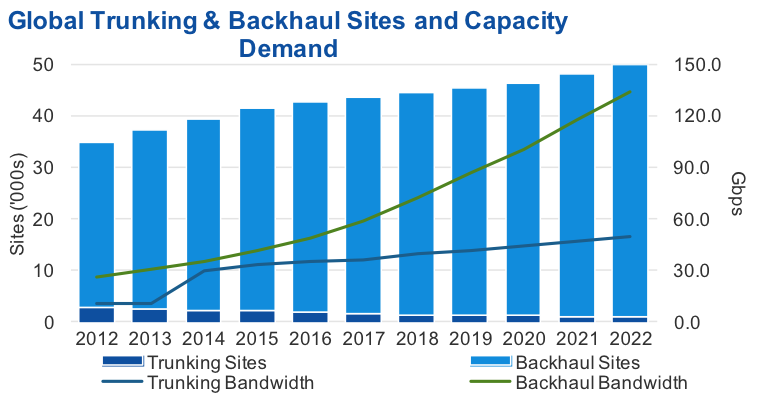Satellite Backhaul &
Trunking are Capacity Driven Markets
Mar 4th, 2014 by
Jose Del Rosario NSR
Within its recently released Broadband Satellite
Markets 12th Edition study, NSR undertook an
assessment of key global trends in the interrelated
satellite backhaul and trunking markets. For the
arguably more important backhaul segment, NSR forecasts a
better than 50% increase in the global installed base of
backhaul sites between 2012 and 2022. Much of this will be
driven by the dual trends towards picocell/smallcell
backhaul and HTS/MEO-HTS provisioned backhaul services.
NSR continues to maintain that the single most important
trend for the satellite backhaul market is the need to cost
effectively serve 3G/4G/LTS backhaul requirements for mobile
operator clients. This will inevitably drive the backhaul
market to the use of HTS and MEO-HTS capacity in the coming
years with NSR projecting that combined HTS/MEO-HTS capacity
demand will grow by 133.5 Gbps by 2022 for backhaul services
alone.
While NSR sees a continued role for C- and Ku-band
provisioned backhaul services over the entire forecast
period, as well as the emergence of some widebeam Ka-band
backhaul networks, it is nonetheless expected that the
installed base of C/Ku backhaul sites will peak in 2015 and
then begin to decline.
For the satellite trunking market, it is no secret that
this segment has been under pressure for the last several
years. The total global base of satellite trunking sites is
projected to drop by almost 70% between 2012 and 2022. Most
of the decline will be for legacy C/Ku-band services giving
way to encroaching undersea cable and terrestrial fiber,
mainly in the Sub-Saharan African and Asian markets.
However, this drop in installed base disguises a critical
trend in the satellite trunking market of new MEO-HTS
provisioned trunking services emerging with capacity cost
points competitive with fiber. Starting with the commercial
launch of O3b Networks service in 2014, NSR expects a
significant increase in trunking bandwidth demand driven
mainly by these high throughout MEO-HTS trunking sites.
Further, NSR believes that the migration to MEO-HTS
capacity will help to stabilize trunking revenues for the
satellite industry. Granted, legacy C/Ku-band trunking
service providers will see declining revenues, but at least
much of that will transition to those players who
successfully sell MEO-HTS and HTS trunking services to end
clients.

Bottom Line
For the combined satellite trunking and backhaul markets,
there is no doubt that the backhaul market vertical
overshadows the trunking market in terms of pure installed
base. Yet, this analysis misses the fact that the trunking
and backhaul markets are much more a satellite capacity play
than an installed base play. In particular, the emergence of
MEO-HTS and HTS provisioned trunking and backhaul sites will
be the key trend in these market verticals in the coming ten
years.
For the last several years, the installed base of mainly
C-band trunking sites has been declining in the face of new
undersea cable and terrestrial fiber. This trend will
continue, however already in 2013 for HTS-provisioned
trunking services and starting in 2014 with MEO-HTS trunking,
NSR expects to see a re-emergence of growth in
satellite-provisioned trunking services as the much more
cost competitive MEO-HTS and HTS trunking solutions begin to
be adopted in many regions around the world.
Similarly, HTS-provisioned backhaul is already making
strong headway in Asia and NSR expects to see the rapid
spread of HTS and MEO-HTS backhaul sites the world over as
the satellite industry seeks to position itself to cost
effectively meet the backhaul needs for rapidly expanding 3G/4G/LTE
networks. There is even real potential for new hybrid
terrestrial/satellite backhaul solutions even for the most
developed countries.